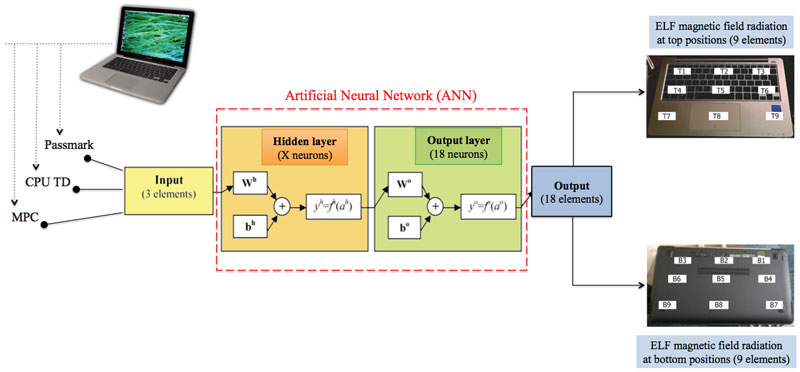by Darko Brodić, Dejan Tanikić (University of Belgrade), and Alessia Amelio (University of Calabria)
Known laptop characteristics can be used to create a model that predicts the extremely low frequency magnetic field radiation emitted at the top and underside of laptops.
Owing to their user-friendly characteristics, particularly their portability and the option of being powered by current or battery, laptops play an important role in many individuals’ lives, with many users becoming quite dependant on them. Typically, when working with a laptop, the user’s body is in constant close contact with the body of the device; either the laptop is on a desk or on the knees of the user. Either way, the laptop is implicitly in contact with the skin, the lymph and the bones of the user.
Because of the current flowing through the laptop’s electronic components, an extremely low frequency (ELF) magnetic field radiation up to 300 Hz is generated at the top and at the bottom parts of the laptop, potentially posing a significant risk to the user's health. In particular, the electric current densities up to 483% higher than the reference level of the International Commission for the Non-ionized Radiation Protection (ICNIRP) are caused by the laptop’s power supply [1]. Also, different studies have analysed the correlation between exposure to ELF magnetic field radiation and the occurrence of serious illnesses, like leukemia and brain cancer.
To eliminate the high risk to users that is associated with everyday ELF magnetic field exposure, we propose a new model for predicting the ELF magnetic field emission from laptops, based on known laptop characteristics during their normal working conditions including popular office programs like Word, Excel and Internet browsing [2]. The model is based on artificial neural networks (ANN), which are software systems inspired by the human central nervous system. In this model, artificial neurons are connected to each other to create the network. The input of the network is a set of three parameters: (i) Passmark, which is the measure that estimates the processor calculation power, (ii) CPU total dissipation (CPU TD) which represents the maximum dissipation that the CPU achieves to process instructions and data, and (iii) Maximum power consumption (MPC), which is the maximum consumption of the laptop in its normal use as well as for charging its battery. The output of the network is the ELF magnetic field radiation that the laptop is likely to emit at its nine positions at the top and nine positions at the bottom. Figure 1 shows the typical measuring positions on a laptop.

Figure 1: Typical positions at the top (left) and bottom (right) of the laptop.
The model is based on the high correlation between three input parameters and the ELF magnetic field emission produced by the laptop, which has been formally demonstrated. Then, we classify the obtained ELF magnetic field emission into three or four dangerousness classes based on the possible effects of the emission on the human body, according to the reference limit extracted from the current safety standards [3]. Figure 2 illustrates the ANN model.

Figure 2: The artificial neural network model.
The proposed model has been tested on 10 laptops of different manufacturers, each characterised by its Passmark, CPU TD and MPC values. First of all, the ELF magnetic field radiation has been measured at the nine positions at the top and at the bottom parts of the laptops. Then, the model has been employed to predict the ELF magnetic field values of the laptops at all 18 positions, given the Passmark, CPU TD and MPC values as input of the model. Comparison between the results obtained from the model and real measured values also demonstrates the accuracy and the efficacy of the model in predicting the highest peaks in magnetic field emission. One of the strengths of the model is that it predicts with great accuracy the dangerousness classes associated with a particular laptop.
In conclusion, this model can play an important role in predicting the distribution, the emission levels and the dangerous levels associated with a given laptop in order to suggest safety rules for working with the device. The model could also provide useful information to manufacturers, helping them to prevent ELF magnetic field laptop emissions by tailoring the inner components that influence laptop characteristics. Consequently, the model could favour the design of low emission laptops.
This study is part of ongoing research involving the Technical Faculty in Bor, University of Belgrade, Serbia and the Department of Computer Science Engineering, Modelling, Electronics and Systems, University of Calabria, Italy. Future work will investigate the efficacy of the model when a laptop operates under conditions of stress.
This work was partially supported by the Ministry of Education, Science and Technological Development of the Republic of Serbia TR33037.
References:
[1] C. V. Bellieni, et al.: “Exposure to Electromagnetic Fields From Laptop Use of “Laptop” Computers”, Archives of Environmental & Occupational Health, 67(1):31-36, 2012.
[2] D. Brodić, D. Tanikić, A. Amelio: “An approach to evaluation of the extremely low-frequency magnetic field radiation in the laptop computer neighborhood by artificial neural networks”, Neural Computing and Applications, Springer, 1-13, 2016.
[3] D. Brodić, A. Amelio: “Detecting of the Extremely Low Frequency Magnetic Field Ranges for Laptop in Normal Operating Condition or Under Stress”, Measurement, Elsevier, 91:318-341, 2016.
Please contact:
Darko Brodić
Technical Faculty in Bor, University of Belgrade, Serbia











